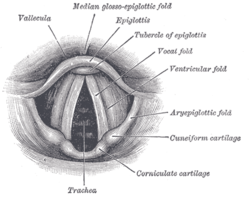
Back Stembande AF Stimmlippe ALS أحبال صوتية Arabic Səs bağı AZ Гласни струни Bulgarian Plecs vocals Catalan Hlasivky Czech Stemmebånd Danish Stimmlippe German Φωνητικές χορδές Greek
| Vocal cords | |
|---|---|
 Laryngoscopic view of the vocal folds. | |
 | |
| Details | |
| Precursor | Sixth pharyngeal arch |
| System | Respiratory system |
| Identifiers | |
| Latin | plica vocalis |
| MeSH | D014827 |
| TA98 | A06.2.09.013 |
| TA2 | 3198 |
| FMA | 55457 |
| Anatomical terminology | |


In humans, the vocal cords, also known as vocal folds, are folds of throat tissues that are key in creating sounds through vocalization. The length of the vocal cords affects the pitch of voice, similar to a violin string. Open when breathing and vibrating for speech or singing, the folds are controlled via the recurrent laryngeal branch of the vagus nerve. They are composed of twin infoldings of mucous membrane stretched horizontally, from back to front, across the larynx. They vibrate, modulating the flow of air being expelled from the lungs during phonation.[1]
The 'true vocal cords' are distinguished from the 'false vocal folds', known as vestibular folds or ventricular folds, which sit slightly superior to the more delicate true folds. These have a minimal role in normal phonation, but can produce deep sonorous tones, screams and growls.
The length of the vocal fold at birth is approximately six to eight millimeters and grows to its adult length of eight to sixteen millimeters by adolescence. DHT, an androgen metabolite of testosterone which is secreted by the gonads, causes changes in the cartilages and musculature of the larynx when present in high enough concentrations, such as during an adolescent boy's puberty: The thyroid prominence appears, the vocal folds lengthen and become rounded, and the epithelium thickens with the formation of three distinct layers in the lamina propria.[citation needed]. These changes are only partially reversible via reconstructive surgery such as chondrolaryngoplasty, feminization laryngoplasty, and laser tuning of the vocal cords.
- ^ Titze IR (January 2008). "The human instrument". Sci. Am. 298 (1): 94–101. Bibcode:2008SciAm.298a..94T. doi:10.1038/scientificamerican0108-94. PMID 18225701. S2CID 33929329.